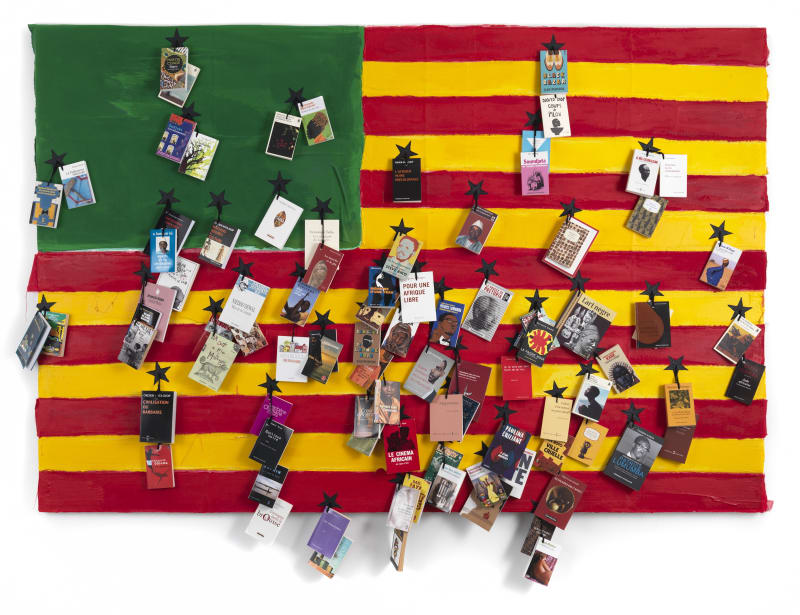Born in 1966 in São Domingos (Guinea-Bissau), Nú Barreto has been living and working in Paris since 1989.
Graduated from the École Nationale des Métiers de l'Image des Gobelins (Paris, France), Nú Barreto has forged a language of his own and developed a multidisciplinary and political practice. His original work was quickly spotted. In 1998, he represented his country at the Lisbon World Fair (Portugal). His work has since then received international exposure and Nú Barreto has established himself as one of the most prominent artists of African contemporary art.
As evidenced by the many solo and group exhibitions dedicated to his work, among which: AFRO, Rencontres avec l'art de l'Afrique contemporaine at the Centre culturel de l'Escale in Levallois-Perret (France) in 2019 ; 0.10 RELOADED Avant-Garde at the Sabine Knust gallery in 2018, in Munich (Germany) where he exhibited alongside William Kentridge, El Anatsui and Isaac Julien ; the great exhibition entitled Lumières d'Afrique, which, between 2015 and 2018, travelled to the Palais de Chaillot in Paris, (France), the Donwahi Foundation in Abidjan (Côte d'Ivoire), the IFAN Museum in Dakar (Senegal), the Palace of Nations in Geneva (Switzerland), the African Union of Addis-Abeba (Ethiopia) and at the EUMETSAT in Darmstadt (Germany) ; Hommage à la Biennale d'Art contemporain africain de Dakar in Martigny (Switzerland), and Convergences held at the headquarter of the West African Economic and Monetary Union in Ouagadougou (Burkina-Faso) in 2016. In 2015, the artist enjoyed his first solo show in China entitled Ressonância at the Taipa House Museum of Macao (China), and took part in Rastros at the Capixaba do Negro Museum (MUCANE) in Vitória (Brazil). Before, in 2013, he was exhibited at the Boribana Museum of Dakar (Senegal) ; at the Arpád Szenes and Viera da Silva Foundation in Lisbon, PLMJ, (Portugal) in 2012 on the occasion of Fundação PLMJ, 100 obras - 10 años ; at the Latin American Foundation of São Paulo (Brazil) in 2011 ; at the Biennale of São Paulo (Brazil) in 2010 ; at the Cité des sciences et de l'industrie de la Villette for the exhibition Quand l'Afrique s'éveillera, in Paris (France) in 2007. In 2006, he took part in the famous Biennial of Contemporary African Art of Dakar (Senegal), as well as in Afrique Europe - rêves croisés, an exhibition organized by the EU Commission at Les Ateliers des Tanneurs in Brussels (Belgium).
Nú Barreto's works are featured in major public collections such as the Musée Capixaba do Negro Museum (MUCANE) in Vitória, Brazil ; the Pro- Justitiae Foundation in Porto, and the Arpád Szenes and Viera da Silva Foundation (PLMJ), in Lisbon, Portugal ; the West African Economic and Monetary Union (UEMOA) in Ouagadougou, in Burkina-Faso ; as well as the Taipa House Museum of Macao in China.
Nú Barreto has been represented by la Galerie Nathalie Obadia, Paris/Brussels, since 2018.
Drawing has been Nú Barreto's favorite medium since childhood. Children would come from neighboring villages to see his drawings, which were the pride of his parents. His works on paper have kept the imaginative liveliness of that time; but they now serve the story of his personal experience of contemporary Africa. And the artist is not complacent. Most of the time, he is bitter and fierce. With his sharp pencils and bloody red paint, Nú Barreto depicts the violence that marked the African continent.
In the midst of this daily reality, Nú Barreto's homo imperfect plays the lead role. Like a mirror, this black and red ink alter ego bring us back to our own inconsistency and confronts us to our responsibility toward Africa's current situation. The homo imperfect is aptly named. His body is distorted by pain and fear. According to the artist, his screaming mouth bears witness of the daily suffering of the African people as well as its collective memory. In that regard, artist Francis Bacon, which paintings so masterfully captured suffering, is a claimed source of inspiration for Nú Barreto, who also mentions Lucian Freud, Willem de Kooning as well as Portuguese painter Paula Rego among his pantheon of reference artists. He borrowed from the latter the subtle blend of realism and symbolism she used for her social satire. The absence of background or spatial reference in Nú Barreto's compositions conveys a strong feeling of dizziness. Like a funambulist, the homo imperfect balances himself on the thread that cut through many of his drawings. In the artist symbolic system, this thread represents the "lifeline", and its recurrence points to the precariousness of existence as much as its permanence.
Other fetish objects, like chairs and ladders, reappear from drawings to drawings. The first one, with its broken leg, symbolizes the chronic instability of African states. The second, with its broken rungs, is a metaphor for the social mobility which stalling contributes to the rise of inequality. Nú Barreto's collection of symbols also includes animals (crows, pigs, chameleons etc.) and obsolete objects like bikes and guitars. On an even stranger note, it rains bananas, nails and even umbrellas, both open and closed. This wide variety of symbols draws from West African aboriginal cultures, which artistic production also resorted to the power of signs. To complete this personal semantic, the artist makes an impressionist use of the red color he has chosen for its symbolic power.
Papers, whether lacerated or ripped off, also play a role in the depiction of the tormented landscape the homo imperfect is creating at his own image. The various iconographic and plastic resources that Nú Barreto uses in his works on paper all contribute to their strong evocative and emotional power, similar to the drawings of South-African artist William Kentridge.
Despite the critical content of his work, the artist continues to have an unfailing trust in men, especially in his homo imperfect, which flaws he likes to ridicule in order for him to correct them. This virtuous power of art has inspired the artist deeply hopeful artworks.
